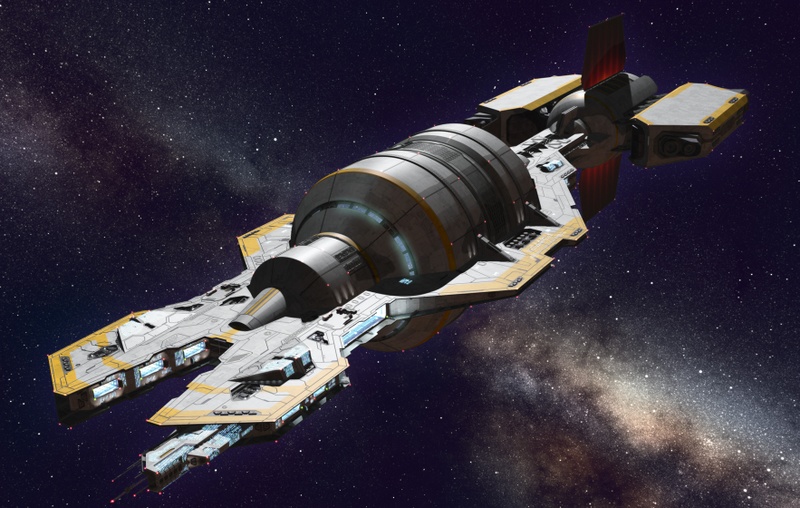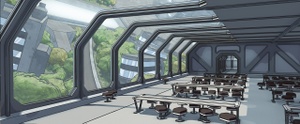Dawn Mothership
| Dawn | ||
|---|---|---|
| Class | Core Ship | |
| Type | Mobile research and exploration base | |
| Length | 4800 m | |
| Dry mass | 2.2 billion tons | |
| Agility | Very low | |
| Skeleton crew | 166 | |
| Passengers | 5,000 - 15,000 (Drum only) | |
| Gravity | Centrifugal | |
| Autonomy | 10 years | |
| Hyperdrive | Yes | |
| Range | 1200 LY | |
| Max. Acceleration | 0.5G | |
| Weapons | • 50 civilian laser turrets | |
| Complement | • 60 shuttles • 20 atmospheric shuttles |
|
| Additional cargo | 25 million tons | |
The Dawn-class ships are the core ships of several research fleets engaged in exploration of space around the Alliance and are among the largest spacecraft in the ranks. In fact, they are like small mobile cities, almost five kilometers in length. The mission of these ships is to form the core of the fleets in which they are located and serve as points of repair, maintenance and rest. Dawn has everything you need for a completely autonomous existence for several years in a row.
In addition to hangars storing a large number of shuttles and industrial bays responsible for the production of various spare parts from raw materials, the most important compartment of the ship is the living module. It is a large cylinder 300 meters in diameter and more than half a kilometer in length. It spins to create 0.9g with centrifugal force, is filled with atmosphere and illuminated by huge day light lamps, and is largely reminiscent of the O'Neill Cylinder concept, except for the absence of giant windows vulnerable to space debris.
The interior of the living section is designed to create the illusion of a small town, with roads, vegetation, a park, and even a pond. Psychological research has shown that during long expeditions in deep space, it is important to have something that at least mimics the planetary surface, since even spacious corridors and rooms eventually begin to cause bouts of depression, especially among representatives of more claustrophobic species, such as the bird-like Ktak that are used to soaring in the sky. Under this recreation area, a little closer to the outer hull, there are living quarters for the population. Under that level is the technical floor, which stretches near the hull itself, containing all the systems that ensure the normal functioning of the interior of the cylinder. It also hosts the vast network of water reservoirs, that acts as both a shield from the radiation and, with the help of a network of pumps, as a dynamic counterweight for smoothing out the tiny shifts of the center of mass caused by people and goods moving around inside of it.
The geometry of the interior of the cylinder may cause slight dizziness at first, but if you do not look up, then it is easy to forget that beneath you is not the earth, but thousands of trillion kilometers of the airless, pitiless, black and cold abyss.
The "skyscraper" to the right of the center is the main building for the administration of the entire expedition; this is where information about the state of the entire fleet flows, and where the CIC and the main archives of the expedition are located.
Sub-park level accommodations are provided with two standardized apartment types - the economy class, which is more like a single hotel room, and the extended class, for families and important crew members, is more like a multi-room apartment.
The apartment itself is divided into two areas: the main room and the bathroom, with a total area of 50 square meters. The bathroom contains a shower, toilet, and a sink with a mirror. The main room contains cabinets, a table, a bed and a wall screen, most often imitating a window using video wallpaper. Economy class apartments do not have much room for individualization of design (besides a selection of furniture and adjusting the parameters of touch panels for specific features of the resident's anatomy), so usually the only piece of furniture that can be moved is a chair on magnetic wheels.
In the buildings located in the park area, there are a number of apartments with a special layout, for crew members with rather unique requirements or proportions, such as the three-meter tall Sashli or the height-loving Ktak. In addition to personalized apartments, parkland buildings contain movie theaters, canteens, mess halls, shops and other establishments to create a localized, simplified, but functional economy within the fleet.
Dawn is a civilian ship, and therefore does not carry any weapons, except for civilian grade laser PDS to protect the ship from dangerous pieces of space debris or meteoroids. Due to the size, the ship is very lumbering and generally slow, and can't accelerate by more than 0.5g. Even that is an unusual acceleration for unusual cases, since the acceleration rate is mostly kept no more than 0.01-0.1G. More often, the ship simply passively drifts on a ballistic trajectory when it is in transit and no hurry, or orbits at a stable high orbit around a planet. Each maneuver is reported 15 minutes in advance via the general communication system since, despite the maneuvers being performed slowly and at low accelerations, this is enough for loose objects to fall off the table, or for unprepared crew members to lose balance. The reactors used on the Dawn are also the largest of the power plants used in mobile structures and produce so much energy that even the reclamation systems are unable to fully absorb the heat generated by it, making Dawn class the only large ship to use radiators in its design.
| Leaving the Cradle | The Cliff World | ||||||
|---|---|---|---|---|---|---|
| Species |
|  | ||||
| Organizations | Alliance | Independent Worlds | Science Corporation | Politics | |||||
| Technologies | Hephrene | Interstellar Travel | Spaceships | |||||
| Places | Planet Harr (Nelnusarr star) | "Shining" Space station | "Dawn" class spaceships | Artifact X | |||||
| Characters | Gharr | Zane | Hekaht | Ahshu | Quantum | Nea | Dan | Mark | Val | ! Virus | |||||
| Events | ! Overall chronology | |||||
| Further reading: | Civilization development stages | Instruments | Ideas | | ||||||






